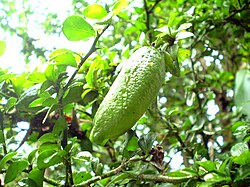
Australian limes are species of the plant genus Citrus that are native to Australia and Papua New Guinea.
Contents
- Species from Australia
- Natural species
- Cultivars
- Species from Papua New Guinea
- Identification
- References
These species were formerly included in the genera Microcitrus and Eremocitrus. [1] [2] [3] They have been used as a food source by indigenous Australians and Indigenous New Guineans as well as early settlers and are used in modern Australian cuisine, including marmalade and sauces. [4] [5]
Species include: [6]
| Australian limes | |


